Monopsony
Monopsony
Courses Info
Level: AS Levels, A Level, GCSE – Exam Boards: Edexcel, AQA, OCR, WJEC, IB, Eduqas – Economics Revision Notes
Monopsony – a market condition in which there is only one buyer for a good / service but several suppliers. Therefore, the buyer is able to set the demand and controls the price
Monopsony in the real world
- Labour Market – occurs when there is a dominant employer but several employees existing in the labour market. An example of this is the Government being the sole employer for civil servants and police officers
- Firms always have a degree of Monopsony power due to geographical and occupational immobilities
- Gig Economy – recent trends toward self-employment; workers in a Gig Economy can easily face a monopsony employer
- Supermarkets – possess monopsony power when buying food and agriculture from farmers
Conditions for a Monopsony to operate
- Single Buyer – a Monopsony will exist when there is only one buyer in the market
- Able to influence the Market Price – firms which possess Monopsony Power are able to determine the market price
- Lower prices – since there is only one buyer in the market, suppliers are limited to where they can sell their products. Therefore, a firm with Monopsony Power is able to negotiate lower prices
- Profit Maximisers – firms which possess Monopsony Power are able to profit maximise
Monopsony Diagram
- Monopsony: A sole employer of labour in a given industry.
- Examples: Teachers and nurses.
- Wage Makers: Monopsonists set wages to maximise revenue by hiring workers where marginal revenue product (MRP) equals the marginal cost of labour.
- Marginal Cost of Labor: Higher than the average cost because increasing wages for all workers is necessary when hiring an additional worker.
- Employment and Wages: Monopsonists hire fewer workers and pay lower wages compared to competitive labour markets.
- Worker Wages: Lower than their MRP.
- Efficiency: Highly inefficient, distorting efficient labour market outcomes.
Trade Union in a Monopsony Labour Market
- Trade Unions Bargain: Aim for higher wages for workers through collective bargaining.
- Supply Control: Strong trade unions can control the supply of labour at specific wage rates, influencing market conditions.
- Union Wage Rate: Unions find monopsonist wages unfair and demand a new, higher wage rate (Wtu).
- Wage Taker Transition: Monopsonists become wage takers at the union wage rate up to a certain employment level, where the labour supply curve becomes horizontal (S = MCL).
- Supply Curve Shift: Beyond this employment level, to attract more workers, monopsonists must increase wages, reverting the marginal cost of labour to the original upward-sloping curve.
Advantages of Monopsony
- Profit Maximise – Suppliers cannot overcharge as the buyers possess the power; this allows firms to make more profit
- Lower Prices – Consumers may experience lower retail prices as firms incur a reduction in their buying costs
- Power – In situations where there is a monopoly supply of resources, monopsony power can give power to buyers
- Innovation, and R&D – Monopsony can generate higher profits which could be used to invest into R&D, innovation and new technology
Disadvantages of Monopsony
- Inequality and Lower Wages – Higher profits generated may lead to inequality and lower wages of workers
- Barrier to Entry – Monopsony acts as a barrier to entry which could restrict the variety and choice of products available to consumers
- Less Competition – Some smaller suppliers may be forced out of business due to other larger suppliers making more profit from the buyer
Quick Fire Questions
1. Define ‘Monopsony’ (2 marks)
2. Identify and explain two real life examples of where a Monopsony may occur (4 marks)
3. Explain four advantages of a Monopsony (8 marks)
4. Explain three disadvantages of a Monopsony (6 marks)
Next Revision Topics
A Level Economics Past Papers


